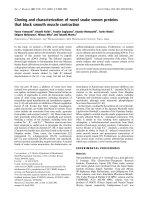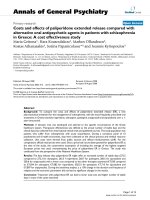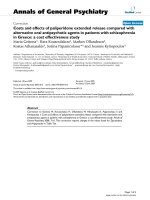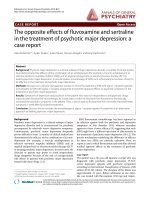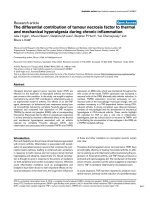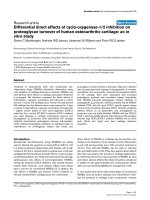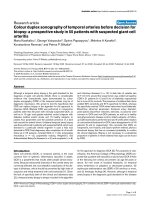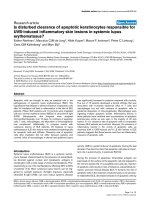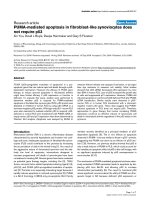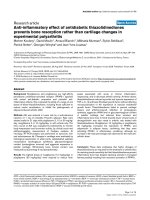Báo cáo y học: " Potential therapeutic effects of branched-chain amino acids supplementation on resistance exercise-based muscle damage in humans" pps
Bạn đang xem bản rút gọn của tài liệu. Xem và tải ngay bản đầy đủ của tài liệu tại đây (203.93 KB, 10 trang )
This Provisional PDF corresponds to the article as it appeared upon acceptance. Fully formatted
PDF and full text (HTML) versions will be made available soon.
Potential therapeutic effects of branched-chain amino acids supplementation on
resistance exercise-based muscle damage in humans
Journal of the International Society of Sports Nutrition 2011, 8:23 doi:10.1186/1550-2783-8-23
Claudia R da Luz ()
Humberto Nicastro ()
Nelo E Zanchi ()
Daniela FS Chaves ()
Antonio H Lancha Jr ()
ISSN 1550-2783
Article type Commentary
Submission date 5 May 2011
Acceptance date 14 December 2011
Publication date 14 December 2011
Article URL />This peer-reviewed article was published immediately upon acceptance. It can be downloaded,
printed and distributed freely for any purposes (see copyright notice below).
Articles in JISSN are listed in PubMed and archived at PubMed Central.
For information about publishing your research in JISSN or any BioMed Central journal, go to
/>For information about other BioMed Central publications go to
/>Journal of the International
Society of Sports Nutrition
© 2011 da Luz et al. ; licensee BioMed Central Ltd.
This is an open access article distributed under the terms of the Creative Commons Attribution License ( />which permits unrestricted use, distribution, and reproduction in any medium, provided the original work is properly cited.
1
Potential therapeutic effects of branched-chain amino acids supplementation on resistance exercise-
based muscle damage in humans
Claudia R da Luz
1
*, Humberto Nicastro
1
, Nelo E Zanchi
1,2
, Daniela F S Chaves
1
and Antonio H Lancha Jr
1
1
Laboratory of Applied Nutrition and Metabolism, School of Physical Education and Sports, University of São
Paulo, São Paulo, SP, Brazil;
2
Institute of Biomedical Science, University of São Paulo, São Paulo,
SP, Brazil.
Email addresses:
CRL:
HN:
NEZ:
DFSC:
AHL Jr:
*Corresponding author:
Claudia Ribeiro da Luz
Laboratory of Applied Nutrition and Metabolism, School of Physical Education and Sports,
University of São Paulo, Av. Prof. Mello Moraes, 65, São Paulo, SP, Brazil, PO Box 05508-030,
Telephone: +55 11 3091 3096 / Fax: +55 11 3091 3136
E-mail:
2
Abstract
Branched-chain amino acids (BCAA) supplementation has been considered an interesting
nutritional strategy to improve skeletal muscle protein turnover in several conditions. In this
context, there is evidence that resistance exercise (RE)-derived biochemical markers of muscle
soreness (creatine kinase (CK), aldolase, myoglobin), soreness, and functional strength may be
modulated by BCAA supplementation in order to favor of muscle adaptation. However, few studies
have investigated such effects in well-controlled conditions in humans. Therefore, the aim of this
short report is to describe the potential therapeutic effects of BCAA supplementation on RE-based
muscle damage in humans. The main point is that BCAA supplementation may decrease some
biochemical markers related with muscle soreness but this does not necessarily reflect on muscle
functionality.
Key words: Leucine, Delayed onset muscle soreness, Creatine kinase, Protein turnover.
3
Introduction
Skeletal muscle damage is a phenomenon that can occur due to several factors, such as
rupture and/or cell necrosis, representing about 10-55% of total muscular injuries [1]. The main
feature of skeletal muscle damage without cell necrosis is the disruption of muscle fibers,
specifically the sheath of basal lamina [1]. Regarding mechanical stimuli, specifically resistance
exercise (RE), it is known that it can promote microdamage in muscle fibers imposed by
contractions and/or overload and, according to the intensity, length, and volume the severity and
degree of damage and discomfort may be compounded over time and persist chronically [2]. As
functional consequence, muscle damage is manifested by a temporary decrease in strength,
increased muscle passive tension, delayed onset muscle soreness (DOMS), and edema [2].
In this context, some prophylactic interventions have been proposed in order to attenuate the
negative effects associated with RE-induced muscle damage. Among the nutritional strategies,
supplementation with branched-chain amino acids (BCAA - leucine, isoleucine, and valine) has
been considered a potential intervention [3, 4]. It is known that these amino acids, particularly
leucine, have anabolic potential by stimulating the initiation of protein translation [5], possibly
suppressing/attenuating muscle proteolysis [6], and offering its transamination product alpha-
ketoisocaproate (α-KIC), widely known to inhibit the enzymatic activity of the branched-chain
alpha-keto dehydrogenase complex (BCKDH) which increases BCAA oxidation [7, 8]. Thus,
BCAA supplementation could promote interesting effects on muscle repair by reducing protein
oxidation, promoting muscle sarcomerogenesis, and improving muscle functional status.
The purpose of this short review is to describe the effects of BCAA supplementation on RE-
induced muscle damage. To this, we considered only human studies since they can elucidate a
possible nutritional strategy with therapeutic potential. This strategy may promote benefits such as
attenuate muscle soreness and improve skeletal muscle turnover to subjects engaged on resistance
exercise program which could favor RE-induced training adaptations. To this end, this report
discusses the basic concepts of muscle damage and its biochemical markers followed by evidences
of effects of BCAA supplementation on RE-induced muscle damage in humans.
Discussion
Cellular responses and biochemical markers of muscle damage
The damage of muscle tissue can be defined as the disruption of plasma membrane
accompanied by the loss of muscle proteins (i.e. creatine kinase (CK), myoglobin, lactate
dehydrogenase (LDH), aldolase, troponin), the influx of serum proteins, increased population of
inflammatory infiltrates in the muscle fibers (i.e. macrophages and neutrophils), DOMS, functional
impairment (strength loss), and possible structural disorders such as sarcomere Z lines
4
disarrangement [9, 10]. Current literature classifies the damage of skeletal muscle in two stages
called primary and secondary damage [2]. The primary damage can be subdivided into two possible
mechanisms: metabolic and mechanical. The metabolic damage has been proposed as a result of
ischemia or hypoxia during prolonged exercise, which may results in changes in ion concentration,
accumulation of metabolic wastes, and deficiency of adenosine triphosphate (ATP) [11].
Mechanical stimuli, however, may induce muscle damage as direct consequence of overload of
muscle fibers or inappropriate balance of exercise variables that can cause the disruption of the
sarcomeric Z lines [2]
,
[9, 10]. The secondary damage can be manifested through processes
associated with exercise that can lead to disruption of intracellular calcium homeostasis and
systemic and local inflammatory response [11]. Of note, it has been proposed that RE-induced
muscle damage may be a necessary step to favor muscle remodeling and adaptation [12]. However,
chronic muscle damage may delay muscle recovery, functionality, and impair protein turnover [13,
14].
Enzymatic skeletal muscle proteins such as CK, LDH, myoglobin, and myosin heavy chain
(MHC) may spill from muscle cells to the serum and be used as quantitative markers of cellular
damage and recovery [15]. RE may affect the structure of skeletal muscle cells at the sarcolemma
and Z disks resulting in increased serum levels of CK. Of note, the time-release and clearance of
CK depends mainly on the type of exercise and its variables (volume, intensity, and duration).
Apparently, this relationship is mainly dependent of intensity and volume [16]. When exercise
intensity is mild/moderate and with low volume, muscle tissue does not undergo significant changes
in membrane permeability [17, 18]. However, with high intensity and low/moderate volume or
low/moderate intensity and with high volume, changes in membrane permeability and increase in
serum CK and the enzymes mentioned above may occur. Importantly, serum CK concentration has
been associated with muscle functional properties such as strength impairment and reduced ATP
resynthesis [9, 19, 20]. LDH is also a widely used marker of cellular damage. It is already known
that mechanical stimuli can induce significant increase of serum LDH and the degree of increase
depends on the intensity and duration of the exercise [19, 21, 22]. This relationship has been
demonstrated in several studies [23, 24, 25]. Myoglobin is another consistently used biochemical
marker of muscle damage. After strenuous exercise, myoglobin is released as a result of degradation
of muscle protein structures [19, 26, 27]. Its serum concentration may be elevated for some days
probably due to the low-grade inflammation. The activity of myoglobin has strong correlation with
the response of neutrophils induced by stress and is therefore a useful marker for monitoring the
integrity of skeletal muscle tissue [19, 26, 27]. Among the markers mentioned above, most studies
observed high inter-subject variability in the activity of CK and LDH in response to RE-induced
5
muscle damage [21, 22, 28]. In contrast, myoglobin appears to be more applicable since their
variability is reduced when compared to the others [27].
BCAA supplementation and RE-induced muscle damage: results of human studies
Recent studies suggest that BCAA supplementation may improve the repair of RE-induced
damaged muscle tissue. Shimomura et al. [29] assessed serum free amino acids concentration in
young untrained women supplemented with BCAA (5.5 g BCAA in 1.0 g of green tea) 15 minutes
prior to performing a squat exercise (7 sets of 20 repetitions). The authors observed that serum
BCAA concentrations were significantly decreased in the placebo group when compared to the
supplemented group (2.2-fold higher), suggesting that the exercise protocol induced significant
BCAA oxidation and the supplementation prevented such effect. Furthermore, another study from
the same group [30] found that BCAA supplementation (5 g) 15 minutes before the same RE
protocol reduced the peak time of muscle soreness (2-3 days after exercise) in young women by
about 45% when compared to the placebo group (dextrin) and this reduction was significant up to 5
days after exercise. These data demonstrate that RE-induced muscle damage increase BCAA uptake
from serum to skeletal muscle in order to be used as energy source and/or participate in translation
initiation signaling pathway involved in muscle remodeling. Functionally, this appears to have
some consequence in muscle pain.
Concerning the time-frame of supplementation, Nosaka et al. [3] evaluated the effects on
muscle damage supplementing an amino acid mixture (BCAA-enriched; 60% of essential amino
acids) 30 minutes before, immediately after, and 4 days post-exercise (900 actions of arm curl with
1.80 to 3.44 kg of range of workload). No significant differences were observed in the
supplemented group 30 minutes before and immediately after exercise regarding muscle soreness
and damage indexes. However, subjects who ingested the amino acid mixture during 4 days post-
exercise presented reduction of serum CK (from 48 to 96 hours), myoglobin (from 24 to 96 hours),
and of muscle soreness (from 24 to 96 hours) when compared with the placebo group. However,
although no significant differences were observed between groups in isometric maximal voluntary
contraction, range of motion, upper arm circumference, and muscle discomfort were decreased up
to 4 days after exercise in the supplemented group. These results demonstrate that BCAA
supplementation may attenuate muscle soreness and this can be related with some biochemical
markers. However, since no results were observed in muscle strength we can postulate that the
benefits of BCAA supplementation do not involve structural modulation. Similar responses were
observed in the study conducted by Sharp & Pearson [31] which supplemented male subjects with
BCAA (1.8 g of leucine, 0.75 g of isoleucine, and 0.75 g of valine) during 3 weeks before and 1
week during a high-intensity total-body RE (3 sets of 8 repetitions maximum, 8 exercises) and
6
observed that serum CK was significantly reduced in BCAA supplemented group during and
following the exercise protocol.
In a very elegant study, Jackman et al. [32] evaluated the effects of BCAA supplementation
(3.5 g of leucine, 2.1 g of isoleucine, and 1.7 g of valine; divided in 4 daily doses) on eccentric
exercise-induced muscle damage. The main feature of this study was that the subjects remained in
dietary control throughout the experimental protocol in order to minimize the possible effects of
other nutrients on the cellular and functional responses. In the exercise day (12 sets of 10 repetitions
at 120% of concentric 1 repetition maximum), subjects consumed the supplement 30 minutes
before, 1.5 hour after, between lunch and dinner, and before bed; on the following 2 days, 4 doses
of supplementation given between meals. Serum CK and myoglobin were significantly increased
after exercise and remained throughout the test period and BCAA supplementation did not
attenuated it. However, muscle soreness increased after exercise and was 64% reduced in BCAA
supplemented group when compared to the placebo group. Thus, it appears that BCAA
supplementation can also modulate muscle soreness independently of biochemical markers. Such
information need to be elucidated by future studies. In practice, these results reinforce the
hypothesis that, although BCAA supplementation does not improve muscle function, it can alleviate
RE-induced muscle soreness and favor the subject to perform another RE session (the phenomenon
called “repeated bout effect”).
Table 1 summarizes the main results described in the text.
Conclusions and perspectives
According to the data presented, BCAA supplementation appears to be an interesting
nutritional intervention to alleviate RE-induced muscle soreness. Although some studies have found
that biochemical markers of muscle damage are reduced after BCAA supplementation, it does not
reflect improved muscle function (at least in short term studies). Paradoxically, although RE,
especially lengthening (eccentric) contractions, is associated with muscle injury, they can also
provide significant protection against future muscle damage and are robustly involved in the
hypertrophy process [33]. However, little is known about the conditions that result in the protective
adaptation involving the repeated bout effect and the role of BCAA supplementation in this context.
Thus, future studies should try chronic BCAA supplementation (and even other amino acids)
against placebo with the same nitrogen load (isonitrogenous supplementation protocol) in order to
evaluate the possible impact on muscle functionality and relate such effects with molecular
pathways involved in muscle repair and regeneration.
List of abbreviations
7
α- KIC: alpha-ketoisocaproate; ATP: adenosine triphosphate; BCAA: branched-chain amino acids;
BCKDH: branched-chain alpha-keto dehydrogenase complex; CK: creatine kinase; DOMS: delayed
onset muscle soreness; LDH: lactate dehydrogenase; MHC: myosin heavy chain; RE: resistance
exercise.
Competing interests
The authors declare that they have no conflict of interests.
Authors´contributions
CRL participated in manuscript design, wrote the first draft of the manuscript. HN, NEZ, and DFSC
participated in the interpretation and preparation of the manuscript. AHL Jr participated in
manuscript design, interpretation and preparation of the manuscript. All authors read and approved
the final manuscript.
Acknowledgments
CRL, HN, NEZ and DFSC are supported by Fundação de Amparo a Pesquisa do Estado de São
Paulo (FAPESP – Grants n
o
2011/04690-6, 2010/07062-3,2010/52561-8 and 2009/52022-2). The
authors also would like to thank FAPESP for financial support (Grant n˚2010/10852-6).
References
1. Cervellin G, Comelli I, Lippi G: Rhabdomyolysis: historical background, clinical, diagnostic and
therapeutic features. Clin Chem Lab Med 2010, 48(6):749-756.
2. Howatson G, van Someren KA: The prevention and treatment of exercise-induced muscle damage.
Sports Med 2008, 38(6):483-503.
3. Nosaka K, Sacco P, Mawatari K: Effects of amino acid supplementation on muscle soreness and damage.
Int J Sport Nutr Exerc Metab 2006, 16(6):620-635.
4. Shimomura Y, Yamamoto Y, Bajotto G, Sato J, Murakami T, Shimomura N, Kobayashi H, Mawatari K:
Nutraceutical effects of branched-chain amino acids on skeletal muscle. J Nutr 2006, 136(2):529S-532S.
5. Nicastro H, Artioli GG, Costa Ados S, Solis MY, da Luz CR, Blachier F, Lancha AH, Jr.: An overview of the
therapeutic effects of leucine supplementation on skeletal muscle under atrophic conditions. Amino Acids
2011, 40(2):287-300.
6. Zanchi NE, Nicastro H, Lancha AH, Jr.: Potential antiproteolytic effects of L-leucine: observations of in
vitro and in vivo studies. Nutr Metab (Lond) 2008, 5(20.
7. Harris RA, Joshi M, Jeoung NH, Obayashi M: Overview of the molecular and biochemical basis of
branched-chain amino acid catabolism. J Nutr 2005, 135(6 Suppl):1527S-1530S.
8. Hutson SM, Sweatt AJ, Lanoue KF: Branched-chain [corrected] amino acid metabolism: implications for
establishing safe intakes. J Nutr 2005, 135(6 Suppl):1557S-1564S.
9. Sorichter S, Puschendorf B, Mair J: Skeletal muscle injury induced by eccentric muscle action: muscle
proteins as markers of muscle fiber injury. Exerc Immunol Rev 1999, 5(5-21.
10. Warren GL, Ingalls CP, Lowe DA, Armstrong RB: Excitation-contraction uncoupling: major role in
contraction-induced muscle injury. Exerc Sport Sci Rev 2001, 29(2):82-87.
8
11. Duncan CJ: Role of calcium in triggering rapid ultrastructural damage in muscle: a study with
chemically skinned fibres. J Cell Sci 1987, 87 ( Pt 4)(581-594.
12. Koh TJ, Pizza FX: Do inflammatory cells influence skeletal muscle hypertrophy? Front Biosci (Elite Ed)
2009, 1(60-71.
13. Depner CM, Kirwan RD, Frederickson SJ, Miles MP: Enhanced inflammation with high carbohydrate
intake during recovery from eccentric exercise. Eur J Appl Physiol 2010, 109(6):1067-1076.
14. Malm C: Exercise-induced muscle damage and inflammation: fact or fiction? Acta Physiol Scand 2001,
171(3):233-239.
15. Mathur S, Sheel AW, Road JD, Reid WD: Delayed onset muscle soreness after inspiratory threshold
loading in healthy adults. Cardiopulm Phys Ther J 2010, 21(1):5-12.
16. Bijsterbosch MK, Duursma AM, Smit MJ, Bos OJ, Bouma JM, Gruber M: Several dehydrogenases and
kinases compete for endocytosis from plasma by rat tissues. Biochem J 1985, 229(2):409-417.
17. Hurley BF, Redmond RA, Pratley RE, Treuth MS, Rogers MA, Goldberg AP: Effects of strength training on
muscle hypertrophy and muscle cell disruption in older men. Int J Sports Med 1995, 16(6):378-384.
18. Serrao FV, Foerster B, Spada S, Morales MM, Monteiro-Pedro V, Tannus A, Salvini TF: Functional
changes of human quadriceps muscle injured by eccentric exercise. Braz J Med Biol Res 2003, 36(6):781-
786.
19. Brancaccio P, Lippi G, Maffulli N: Biochemical markers of muscular damage. Clin Chem Lab Med 2010,
48(6):757-767.
20. Brancaccio P, Maffulli N, Limongelli FM: Creatine kinase monitoring in sport medicine. Br Med Bull
2007, 81-82(209-230.
21. Kobayashi Y, Takeuchi T, Hosoi T, Yoshizaki H, Loeppky JA: Effect of a marathon run on serum
lipoproteins, creatine kinase, and lactate dehydrogenase in recreational runners. Res Q Exerc Sport 2005,
76(4):450-455.
22. Koukourakis MI, Giatromanolaki A, Sivridis E: Lactate dehydrogenase isoenzymes 1 and 5: differential
expression by neoplastic and stromal cells in non-small cell lung cancer and other epithelial malignant
tumors. Tumour Biol 2003, 24(4):199-202.
23. Priest JB, Oei TO, Moorehead WR: Exercise-induced changes in common laboratory tests. Am J Clin
Pathol 1982, 77(3):285-289.
24. Munjal DD, McFadden JA, Matix PA, Coffman KD, Cattaneo SM: Changes in serum myoglobin, total
creatine kinase, lactate dehydrogenase and creatine kinase MB levels in runners. Clin Biochem 1983,
16(3):195-199.
25. Stokke O: Clinical chemical changes in physical activity. Scand J Soc Med Suppl 1982, 29(93-101.
26. Cockburn E, Hayes PR, French DN, Stevenson E, St Clair Gibson A: Acute milk-based protein-CHO
supplementation attenuates exercise-induced muscle damage. Appl Physiol Nutr Metab 2008, 33(4):775-
783.
27. Neubauer O, Konig D, Wagner KH: Recovery after an Ironman triathlon: sustained inflammatory
responses and muscular stress. Eur J Appl Physiol 2008, 104(3):417-426.
28. Beaton LJ, Tarnopolsky MA, Phillips SM: Contraction-induced muscle damage in humans following
calcium channel blocker administration. J Physiol 2002, 544(Pt 3):849-859.
29. Shimomura Y, Kobayashi H, Mawatari K, Akita K, Inaguma A, Watanabe S, Bajotto G, Sato J: Effects of
squat exercise and branched-chain amino acid supplementation on plasma free amino acid
concentrations in young women. J Nutr Sci Vitaminol (Tokyo) 2009, 55(3):288-291.
30. Shimomura Y, Harris RA: Metabolism and physiological function of branched-chain amino acids:
discussion of session 1. J Nutr 2006, 136(1 Suppl):232S-233S.
31. Sharp CP, Pearson DR: Amino acid supplements and recovery from high-intensity resistance training. J
Strength Cond Res 2010, 24(4):1125-1130.
32. Jackman SR, Witard OC, Jeukendrup AE, Tipton KD: Branched-chain amino acid ingestion can
ameliorate soreness from eccentric exercise. Med Sci Sports Exerc 2010, 42(5):962-970.
33. Zanchi NE, Lancha AH, Jr.: Mechanical stimuli of skeletal muscle: implications on mTOR/p70s6k and
protein synthesis. Eur J Appl Physiol 2008, 102(3):253-263.
9
Table
Table 1 – Studies investigating the effects of BCAA supplementation of RE-based muscle damage
in humans
Study Exercise Protocol Supplementation Protocol Results
Shimomura
et al. [29]
Squat (7 sets of 20
repetitions)
5.5 g of BCAA within 1.0 g of
green tea 15 min before exercise
Attenuation of exercise-
induced serum BCAA
oxidation.
Shimomura
et al. [30]
Squat (7 sets of 20
repetitions)
5.0 g of BCAA 15 min before
exercise
Reduction of peak time
of muscle soreness
induced by exercise.
Nosaka et
al.[3]
900 actions (30 min)
of arm curl with 1.80
to 3.44 kg of range
of workload
BCAA-enriched amino acid
mixture (60% of the essential
amino acids)
Reduction of serum CK,
myoglobin, and muscle
soreness. No differences
in isometric MVC.
Sharp &
Pearson [31]
Whole body RE (3
sets of 8 RM, 8
exercises)
BCAA (1.8 g of leucine, 0.75 g
of isoleucine, and 0.75 g of
valine) 3 weeks before and 1
week during exercise protocol
Reduction of serum CK.
Jackman et
al. [32]
Eccentric exercise
(12 sets of 10
repetitions at 120%
of concentric 1RM)
~ 7.0 g of BCAA/day (divided in
4 doses) on the following 2 days
after exercise
No differences in serum
CK and myoglobin;
Attenuation in exercise-
induced muscle
soreness.
BCAA = branched-chain amino acids; CK = creatine kinase; MVC = maximal voluntary
contraction; RE = resistance exercise; RM = repetition maximum.
